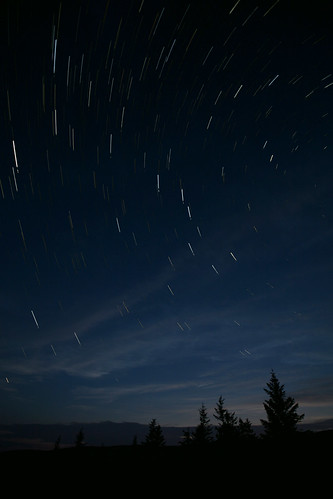Of Mount Desert Island's eminences Gorham is unlikely to be listed among the most well-known peaks. It is far from the tallest mountain, Cadillac towers above it by more than a thousand feet. It does not have any trails with challenges like Champlain's Precipice Trail or The Beehive's south face trail. However, while it is difficult to quantify its panoramic beauty, there is no doubt that the vista of forest and ocean that can be seen from just south of the summit is among the best places to experience what makes Mount Desert so unique. From where the summit begins to drop away in a series of jointed steps the eastern and southern sides of the island where the mountain disappears into the sea can be seen including Sand Beach, Otter Point, and Seal Cove.
But the view is only part of what makes Gorham Mountain an ideal place for nighttime photography; on summer evenings the Milky Way is in the south over the ocean. The peak, behind and to the north, casts a long dark shadow where the lights of Bar Harbor and Ellsworth are blotted out. The distance from the nearest parking to the summit is not far and takes only minutes to hike.
Gorham Mountain Trail starts at the Park Loop Road and proceeds up the south ridge of the mountain. This same ridge with a trail riding it continues on from Gorham's summit where it joins with The Beehive. From this point the ridge pushes north to the height of Champlain Mountain. If Cadillac Mountain is the king of Mount Desert then Champlain is its powerful queen. Champlain commands the north and east sides of the island with its challenging trails to the summit and an all-encompassing view of Frenchman Bay.
The sun is just setting as we begin to head up the trail. From the parking lot the trail ascends over ledges and eroded dips, at the bronze Bates marker it splits into parallel trails that merge back together near the summit; we take the upper trail. As we get near the summit the trees become more scattered and shorter, we are entering the typical approach to the bare peak of a Mount Desert Island mountain. The granite here is scoured and undulating, low spots accumulate sand, pine needles, and water. In other places a thin layer of sandy soil, home to wild Blue Berries and small Pitch Pines, perches atop the stone.
Near the peak at the edge of a small ledge I begin scouting the terrain looking for the best location to make a long exposure photograph of the Milky Way; it needs the right balance between foreground granite, middle ground forest and water, and distant sky. I try to envision the trailing glow of the Milky Way arching overhead in the dark however I am distracted by the inauspicious fog that is pushing north up the bay and beginning to climb into the sky. The fog, rising like a breaking wave, smashes the original plan; the Milky Way will be hidden tonight behind clouds.
Turning from the southeast to the west the sky is clear and dark blue now that the sun is well down. Only thin wisps of cloud float like streamers. Saturn blazes near the horizon and the brightest stars are making their appearances. I decide to try to photograph in this direction; I compose the image of coniferous trees and azure sky then begin making test exposures. After half an hour the lingering twilight has evaporated into the black of night and I start the camera operating on its own. Now there is only waiting.

Stars Over Gorham Mountain
Sarah and I lie on the rock by the edge and look straight up into the starry sky. The bell buoy marking The Thrumcap rings out a muted warning as it is rocked gently by an unusually placid ocean. A separate beat is played out by the legato rasp and then staccato thump of waves breaking on the sloping granite below. The crash of each wave can be felt, as much as heard, through the ground beneath us. I press a hand flat against the rough surface. The granite is comfortably warm, emitting the heat it absorbed all day under the sun. Overhead the stars circle imperceptibly and I consider how it is that of all the light that has left their surfaces these tiny amounts have travelled from distant space and deep time to form the beautiful night sky I see above me. My perception of Gorham Mountain, of its enormous size and solidity changes, and the mountain shrinks becoming infinitesimal. My view of the universe has become boundless and I feel as if I will float off of the mountain into space if I don't hold on tightly.
Finally all the pictures that can be made tonight are finished. Reluctantly we get out our lights and I pack the equipment, putting away the camera and collapsing the tripod; I slip my arms into the straps of the camera pack and we start descending. With headlamps we can only see a dozen or so feet in front of us. On heavily trafficed rocky ground it can be difficult to be certain where the trail is, so we stop fairly often to locate a cairn or blaze to be certain we have not wandered off course. Below the treeline it doesn't feel as if the warm air is moving at all, and the forest is absolutely quiet, the only sound is from our boots scuffing the ground. At last the sign marking the trail head comes into view; we haven't encountered another person the entire time, and our time spent with ocean, mountain, and stars is ended.